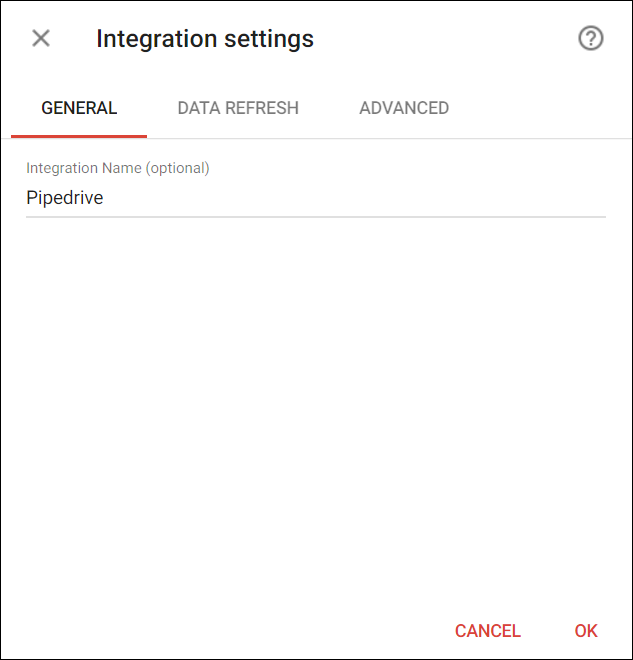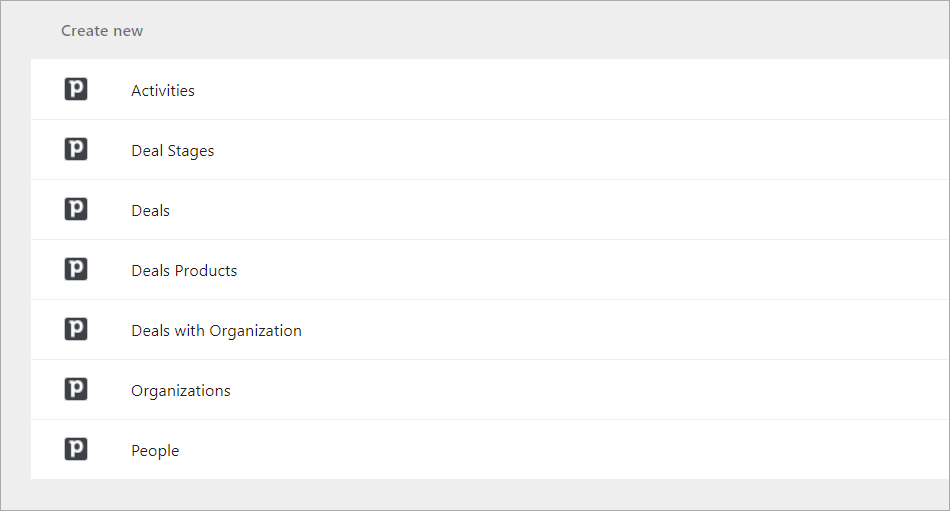Pipedrive is a simple sales pipeline management tool loved by small and medium sized sales teams. Pipedrive makes you focus on the important deals first.
In this article, you’ll find the answers to the following questions:
- How to connect my Pipedrive account with Slemma?
- How to get data from Pipedrive?
- How to create a chart on my Pipedrive integration?
Creating an Integration
From your Slemma account, head over to the Library page and click the plus button at the bottom right. Select Integration from the submenu.
In the following page, you can find Pipedrive with one of the following ways:
- Scroll down and select Pipedrive from the list of Integrations.
- Use search to find Pipedrive from the list of Integrations.
- Choose Pipedrive using All dropdown list > CRM.
You’ll see the Integration settings dialog window.
You can select the frequency for the automatic updates on the DATA REFRESH tab (for Pipedrive datasets, you can enable Incremental updates option), or set weeks settings on the ADVANCED tab. Click OK.

You’ll be directed to a page to sign in. Enter the email address and password to log into your Pipedrive account.
After authorization, you’ll be able to share the integration with either individuals or the entire Team, rename or remove the integration. To view the options available for the integration, right click it in the list.
Creating a Dataset
A dataset is a collection of data in a tabular format that is created on one of the possible data sources. The datasets can be used to create dashboards or individual charts.
To create a dataset, click your Pipedrive integration in the list and select Browse datasets. From the following page, select which data you want to add to use in your charts.

NOTE: Cloud Service Integrations have prebuilt data sets that are not editable.
Click dataset’s name for a description of each dataset.
This data source contains information about your Activities such as the associated deal and the Activity type (including custom types). Dimensions Measures Templates Instead of starting from scratch when building a chart, you can use a pre-built visualization. Simply click one of the templates from the list and it will be added to the dashboard filled with your data. You can then edit and customize this template like a usual chart created by you. The following template available for this dataset: This data source contains information about your Stages. While the Deals data source lets you analyze certain deals, this data source is focused on the performance of your Pipeline itself. An example is the average time a deal is in a certain Stage. Dimensions Measures This data source contains information about your Deals such as how many are currently in a certain stage and when are your highest value deals expected to close. Dimensions + All Custom Dimensions – custom fields without ‘Numerical’ type data. Measures +All Custom Measures – All custom fields which have ‘Numerical’ or ‘Monetary’ type Templates Instead of starting from scratch when building a chart, you can use a pre-built visualization. Simply click one of the templates from the list and it will be added to the dashboard filled with your data. You can then edit and customize this template like a usual chart created by you. The following template available for this dataset: This data source contains information about your Deals with custom fields from the organization. Dimensions + All Custom Dimensions + All Custom Dimensions from Organizations Measures +All Custom Measures – All custom fields which have ‘Numerical’ or ‘Monetary’ type +Custom Measures from Organizations This data source contains information about your products as they relate to deals such as the quantity of certain products to be sold by estimated deal close date. Dimensions + All Custom Dimensions – custom fields without ‘Numerical’ type data. + Custom Dimensions from Deals dataset Measures +All Custom Measures – All custom fields which have ‘Numerical’ or ‘Monetary’ type This data source contains information about your Organizations such as their latest activity and the number of messages associated with that organization. Dimensions + All Custom Dimensions – custom fields without ‘Numerical’ type data. Measures +All Custom Measures – All custom fields which have ‘Numerical’ or ‘Monetary’ type Templates Instead of starting from scratch when building a chart, you can use a pre-built visualization. Simply click one of the templates from the list and it will be added to the dashboard filled with your data. You can then edit and customize this template like a usual chart created by you. The following template available for this dataset: This data source contains information about your contacts such as when they were created, the number of won/lost deals for the contact, and completed activities. Dimensions + All Custom Dimensions – custom fields without ‘Numerical’ type data. Measures +All Custom Measures – All custom fields which have ‘Numerical’ or ‘Monetary’ type Templates Instead of starting from scratch when building a chart, you can use a pre-built visualization. Simply click one of the templates from the list and it will be added to the dashboard filled with your data. You can then edit and customize this template like a usual chart created by you. The following template available for this dataset:
Formula: (Current date) – (Last stage change)
Formula: If a status = “Won” then (Won Time- Created At). If a status <> “Won” then (Current Date)-(Created At)
Formula: (Current date) – (Last stage change)
Formula: If a status = “Won” then (Won Time- Created At). If a status <> “Won” then (Current Date)-(Created At)
When creating new dataset, you can set a time period for data from your service to be uploaded and represented. Go here to learn more about selecting/changing time period for data in your dataset.

Creating a Chart
Click a dataset or integration and select Create dashboard/Create saved chart/Create presentation to start building a chart (please note that presentations are available starting from the Standard Plan).
From the next page, you can choose to create your own chart from scratch, or you can apply one of the templates we created.
- If you choose to build a new chart from scratch (“Blank” option), the Chart designer will open. Go here to learn how to create a chart in the Chart designer.
- If you choose a template, a new chart will be added to a dashboard/saved chart/presentation (depending on the way you start the chart creation).

